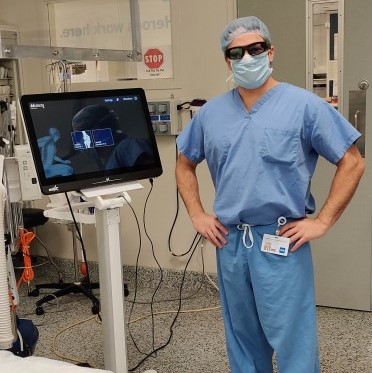Featured
First knee replaced via AR
An orthopedic surgeon at the Hospital for Special Surgery (HSS) has performed the first augmented reality (AR) knee replacement in the United States. The new technology was designed and engineered with artificial intelligence and machine learning.
Augmented reality refers to digital information that is superimposed on a user’s view of the physical environment. An example would be a design app that allows you to visualise a 3D model of furniture or decor in your home before you buy it.
The augmented reality knee replacement platform, known as NextAR TKA, received clearance from the U.S. Food and Drug Administration (FDA) in July. It utilises a preoperative CT scan of the patient’s knee for surgical planning and the use of augmented reality glasses during surgery. The smart glasses allow the orthopedic surgeon to visualise the structures of the knee and track progress in real time directly on the operative field, without having to look over at a computer screen.
“It’s like a car that has the speedometer projected on the windshield, so you don’t have to look down when you’re driving,” says Jonathan Vigdorchik, MD, the orthopedic surgeon who performed the procedure last week at HSS. Taking the car analogy one step further, he compares the AR knee replacement platform to GPS. “Everyone knows how to drive home, but you use GPS technology to find the best and most efficient route to take.”
Dr. Vigdorchik notes that the enhanced visualisation provided by the augmented reality platform allows for ultraprecise alignment and positioning of the knee implant. “Over the past few years, we’ve learned that optimal balancing of the knee ligaments results in a joint replacement that feels more natural and lowers the risk of instability,” he explains. “Every person’s knee is different in terms of their ligaments. Some ligaments are tighter, some are looser. The platform provides direct tracking of the collateral ligaments and a 3D analysis of soft tissue throughout the whole range of motion during surgery, and this allows for optimal ligament balancing for each patient.”
The compact, streamlined nature of the system could also provide economic benefits to the healthcare system, according to Dr. Vigdorchik. “It’s a portable system that can be used in ambulatory surgery centers in addition to hospital ORs,” he says. “In addition, the high level of precision of the AR platform could decrease operating time and translate into greater efficiency. This is particularly advantageous in the current health care environment, as surgeons and hospitals may still be catching up on elective knee replacements that were deferred during the pandemic lockdown.”
Dr. Vigdorchik notes that as more surgeries are performed with the AR system, he will follow patients and collect data to see how the technology compares to robotic-assisted navigation and standard knee replacement surgeries. The ultimate goal is to provide personalised care and achieve the best outcome for each individual patient.
Share
- Click to share on X (Opens in new window) X
- Click to share on Facebook (Opens in new window) Facebook
- Click to share on LinkedIn (Opens in new window) LinkedIn
- Click to email a link to a friend (Opens in new window) Email
- Click to share on Reddit (Opens in new window) Reddit
- Click to share on WhatsApp (Opens in new window) WhatsApp
- Click to share on Pinterest (Opens in new window) Pinterest
| Thank you for Signing Up |



















